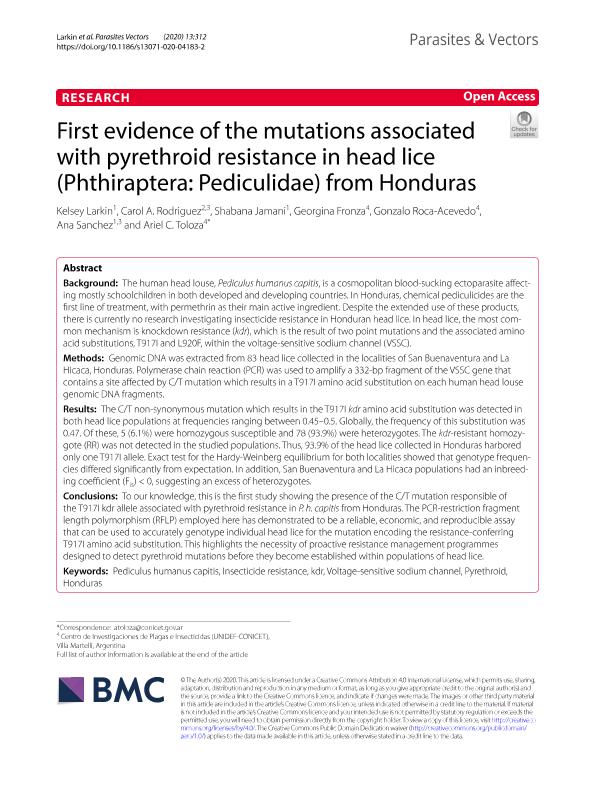Mostrar el registro sencillo del ítem
dc.contributor.author
Larkin, Kelsey
dc.contributor.author
Rodriguez, Carol A.
dc.contributor.author
Jamani, Shabana
dc.contributor.author
Fronza, Georgina

dc.contributor.author
Roca Acevedo, Gonzalo

dc.contributor.author
Sanchez, Ana
dc.contributor.author
Toloza, Ariel Ceferino

dc.date.available
2021-10-15T01:36:24Z
dc.date.issued
2020-06
dc.identifier.citation
Larkin, Kelsey; Rodriguez, Carol A.; Jamani, Shabana; Fronza, Georgina; Roca Acevedo, Gonzalo; et al.; First evidence of the mutations associated with pyrethroid resistance in head lice (Phthiraptera: Pediculidae) from Honduras; BioMed Central; Parasites and Vectors; 13; 1; 6-2020; 1-7
dc.identifier.issn
1756-3305
dc.identifier.uri
http://hdl.handle.net/11336/143723
dc.description.abstract
Background: The human head louse, Pediculus humanus capitis, is a cosmopolitan blood-sucking ectoparasite afect‑ ing mostly schoolchildren in both developed and developing countries. In Honduras, chemical pediculicides are the frst line of treatment, with permethrin as their main active ingredient. Despite the extended use of these products, there is currently no research investigating insecticide resistance in Honduran head lice. In head lice, the most com‑ mon mechanism is knockdown resistance (kdr), which is the result of two point mutations and the associated amino acid substitutions, T917I and L920F, within the voltage-sensitive sodium channel (VSSC). Methods: Genomic DNA was extracted from 83 head lice collected in the localities of San Buenaventura and La Hicaca, Honduras. Polymerase chain reaction (PCR) was used to amplify a 332-bp fragment of the VSSC gene that contains a site afected by C/T mutation which results in a T917I amino acid substitution on each human head louse genomic DNA fragments. Results: The C/T non-synonymous mutation which results in the T917I kdr amino acid substitution was detected in both head lice populations at frequencies ranging between 0.45–0.5. Globally, the frequency of this substitution was 0.47. Of these, 5 (6.1%) were homozygous susceptible and 78 (93.9%) were heterozygotes. The kdr-resistant homozy‑ gote (RR) was not detected in the studied populations. Thus, 93.9% of the head lice collected in Honduras harbored only one T917I allele. Exact test for the Hardy-Weinberg equilibrium for both localities showed that genotype frequen‑ cies difered signifcantly from expectation. In addition, San Buenaventura and La Hicaca populations had an inbreed‑ ing coefcient (Fis) < 0, suggesting an excess of heterozygotes. Conclusions: To our knowledge, this is the frst study showing the presence of the C/T mutation responsible of the T917I kdr allele associated with pyrethroid resistance in P. h. capitis from Honduras. The PCR-restriction fragment length polymorphism (RFLP) employed here has demonstrated to be a reliable, economic, and reproducible assay that can be used to accurately genotype individual head lice for the mutation encoding the resistance-conferring T917I amino acid substitution. This highlights the necessity of proactive resistance management programmes designed to detect pyrethroid mutations before they become established within populations of head lice.
dc.format
application/pdf
dc.language.iso
eng
dc.publisher
BioMed Central

dc.rights
info:eu-repo/semantics/openAccess
dc.rights.uri
https://creativecommons.org/licenses/by-nc-sa/2.5/ar/
dc.subject
HONDURAS
dc.subject
INSECTICIDE RESISTANCE
dc.subject
KDR
dc.subject
PEDICULUS HUMANUS CAPITIS
dc.subject
PYRETHROID
dc.subject
VOLTAGE-SENSITIVE SODIUM CHANNEL
dc.subject.classification
Zoología, Ornitología, Entomología, Etología

dc.subject.classification
Ciencias Biológicas

dc.subject.classification
CIENCIAS NATURALES Y EXACTAS

dc.title
First evidence of the mutations associated with pyrethroid resistance in head lice (Phthiraptera: Pediculidae) from Honduras
dc.type
info:eu-repo/semantics/article
dc.type
info:ar-repo/semantics/artículo
dc.type
info:eu-repo/semantics/publishedVersion
dc.date.updated
2021-09-07T15:18:07Z
dc.journal.volume
13
dc.journal.number
1
dc.journal.pagination
1-7
dc.journal.pais
Reino Unido

dc.journal.ciudad
Londres
dc.description.fil
Fil: Larkin, Kelsey. Brock University; Canadá
dc.description.fil
Fil: Rodriguez, Carol A.. Universidad Nacional Autónoma de Honduras; Honduras
dc.description.fil
Fil: Jamani, Shabana. Brock University; Canadá
dc.description.fil
Fil: Fronza, Georgina. Consejo Nacional de Investigaciones Científicas y Técnicas. Unidad de Investigación y Desarrollo Estratégico para la Defensa. Ministerio de Defensa. Unidad de Investigación y Desarrollo Estratégico para la Defensa; Argentina
dc.description.fil
Fil: Roca Acevedo, Gonzalo. Consejo Nacional de Investigaciones Científicas y Técnicas. Unidad de Investigación y Desarrollo Estratégico para la Defensa. Ministerio de Defensa. Unidad de Investigación y Desarrollo Estratégico para la Defensa; Argentina
dc.description.fil
Fil: Sanchez, Ana. Brock University; Canadá. Universidad Nacional Autónoma de Honduras; Honduras
dc.description.fil
Fil: Toloza, Ariel Ceferino. Consejo Nacional de Investigaciones Científicas y Técnicas. Unidad de Investigación y Desarrollo Estratégico para la Defensa. Ministerio de Defensa. Unidad de Investigación y Desarrollo Estratégico para la Defensa; Argentina
dc.journal.title
Parasites and Vectors

dc.relation.alternativeid
info:eu-repo/semantics/altIdentifier/url/https://parasitesandvectors.biomedcentral.com/articles/10.1186/s13071-020-04183-2
dc.relation.alternativeid
info:eu-repo/semantics/altIdentifier/doi/http://dx.doi.org/10.1186/s13071-020-04183-2
Archivos asociados
